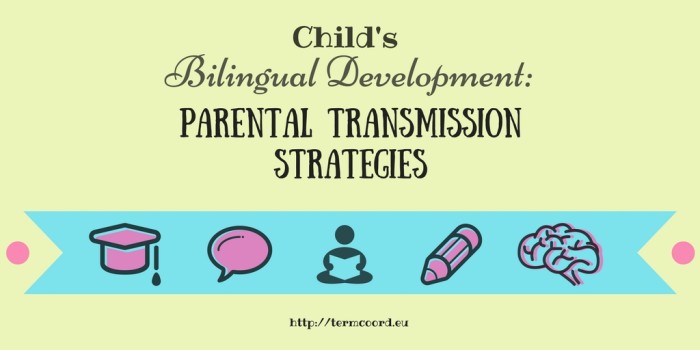This article is a follow-up of the previous post on “How Parents Can Enhance Child’s Bilingual Development?” and it focuses on the parental transmission strategies to achieve the child’s linguistic development, it defines how these strategies differ and how efficient they are.

Parental Transmission Strategies
One person, one language strategy (1P/1L)
 Bilingual parents are often advised to use only one language when communicating with their child if raising the children bilingualism is their goal. The previous research report often uses of 1P/1L strategy by the bilingual parents who have different language background (Barron-Hauwaert, 2004; Romaine, 1995). Under the 1P/1L strategy, in which every parent uses only one language when addressing a child, it is assumed that the child will address each parent only in the expected language. This will lead to the active language use in both languages. However, Mishina-Mori (2011) argue that a parent’s persistent use of a certain language does not automatically imply children’s reply in the target language.
Bilingual parents are often advised to use only one language when communicating with their child if raising the children bilingualism is their goal. The previous research report often uses of 1P/1L strategy by the bilingual parents who have different language background (Barron-Hauwaert, 2004; Romaine, 1995). Under the 1P/1L strategy, in which every parent uses only one language when addressing a child, it is assumed that the child will address each parent only in the expected language. This will lead to the active language use in both languages. However, Mishina-Mori (2011) argue that a parent’s persistent use of a certain language does not automatically imply children’s reply in the target language.
Parents chose 1P/1L because they feel a stronger emotional link when talking to their child in their first language (Pavlenko, 2004; Kirsch 2011) or when the first language is the tool which enables the connection to the cultural heritage (Mills, 2004; Kirsch 2011). Furthermore, some languages are nowadays seen as the commodities. Consequently, an early language exposure to a second language which is considered to be valuable has become a goal for both bilingual and monolingual parents. In some cases, even the monolingual parents hire a nanny who speaks a prestigious language expecting that the exposure to that language would result in a child being proficient in two languages.
Nevertheless, the strategy has not escaped criticism. Early studies of 1P/1L have been carried out by the parent who was a linguist (Kirsch, 2011; Venables, Eisenchlas, & Schalley, 2013).  Moreover, the 1P/1L is supposed to derivate a bilingual child who would actively use two languages and who would not mix those languages which are still unduly seen as a sign of language confusion. Nonetheless, this assumption is not confirmed by the research so far. According to Quay (2008, p. 2), “language mixing in cases of simultaneous bilingual acquisition is being viewed increasingly as reflecting the development of pragmatic competence on the road to gaining code-switching skills.” Patterson (1999) conducted a study witch shows no difference in the incidence of code-switching between families who used 1P/1L or 1P/2L strategy.
Moreover, the 1P/1L is supposed to derivate a bilingual child who would actively use two languages and who would not mix those languages which are still unduly seen as a sign of language confusion. Nonetheless, this assumption is not confirmed by the research so far. According to Quay (2008, p. 2), “language mixing in cases of simultaneous bilingual acquisition is being viewed increasingly as reflecting the development of pragmatic competence on the road to gaining code-switching skills.” Patterson (1999) conducted a study witch shows no difference in the incidence of code-switching between families who used 1P/1L or 1P/2L strategy.
Despite being commonly assumed that 1P/1L is the most efficient strategy regarding a minority language use, Yamamoto (2001) states that this strategy enhances the understanding of two languages but does not lead to the active proficiency in a minority language. The idea that bilingual parent would use only one language when addressing their child was challenged by Goodz (1989), Houwer (2009) and Venables, Eisenchlas and Schalley (2013). Their research, based on the child-parent conversations, show that most of the parents occasionally use more than one language when communicating with the child. These findings undermine previous research which considered that the 1P/1L strategy implies strict language separation. Another criticism of the 1P/1L strategy, made by De Houwer (2009), is that this strategy does not guarantee the children will become active bilinguals. Since the 1P/1L strictly prescribes one language per one parent, the trilingual families find the 1P/1L impractical and strange (Barron-Hauwaert, 2000).
One person, two languages (1P/2L)

Certain fears are often linked to 1P/2L strategy; parents often worry that learning two languages simultaneous would be overly demanding for the children. Moreover, they consider that learning one language would be done at the expense of another one, so a child first needs to acquire a good basis of one language for it to be possible to learn a new one (Barron-Hauwaert, S., 2004; De Houwer 2009; Grosjean, F., 2010).
Effectiveness of 1P/1L, 1P/2L and 1P/1L & 1P/2L
As aforementioned, the 1P/1L is the most recommended strategy to parents. However, the 1P/1L is the least used strategy, while the 1P/1L & 1P/2L is most frequently used strategies which parents use when addressing children (De Houwer, 2007, 2009; Yamamoto, 2001). De Houwer (2007) asserts the number of languages the parents use in bilingual child upbringing does not determine the proficiency outcome.
The importance of differentiation between the status of a language within the 1P/1L & 1P/2L strategy needs to be underpinned, as it has been shown as the deciding factor. Within the 1P/1L & 1P/2L strategy, a language both parents share can be societal or minority language. De Houwer (2007) and Yamamoto (2001) underscore that a language exposure the parents provide the children with, is more crucial factor than the number of languages parents address the children when the active bilingualism is concerned. In other words, if the parents share a minority language at home, the chances that a child will be proficient in two languages are remarkably higher than in a case when the parents share a majority language within the family setting (see Table 1). De Houwer (2009) holds the view that an input frequency has an essential role in a child’s ability to speak two languages. To sum up, within the 1P/1L and 1P/2L strategy, the 1P/2L is the one that more often leads to the active bilingualism (Houwer, 2009; Yamamoto (2001).
Table 1
Effectiveness of 1P/1L & 1P/2L strategy
| De Houwer (2007) | Children speak two languages | Children speak only one language | N |
| All | 59.23% | 40.77% | 596 |
| Societal language is shared | 35.70% | 63.30% | 353 |
| Minority language is shared | 93.42% | 6.58% | 243 |
| Yamamoto (2001) | |||
| All | 77 | 11 | 88 |
| Societal language is shared | 16 | 11 | 27 |
| Minority language is shared | 61 | – | 61 |
Adopted from Box 4.15 in De Houwer, 2009; 113
Language Choice
 Bilingual children have three choices regarding the language used while speaking: (1) language A; (2) language B; (3) and the combination of the two languages; language AB. However, having the triple choice does not necessary mean the bilinguals can use the languages when they want. De Houwer (2009) highlights the existence of the non-explicit social rules for language choice that the children need to learn. Besides, which language is appropriate in a given situation rely upon the interlocutor’s expectations, but it is important to emphasize that the children can learn it quite fast and from a very early age (De Houwer, 2009). The rules which language a child should speak may depend on the topic of conversation, the interlocutor or the place where the person is.
Bilingual children have three choices regarding the language used while speaking: (1) language A; (2) language B; (3) and the combination of the two languages; language AB. However, having the triple choice does not necessary mean the bilinguals can use the languages when they want. De Houwer (2009) highlights the existence of the non-explicit social rules for language choice that the children need to learn. Besides, which language is appropriate in a given situation rely upon the interlocutor’s expectations, but it is important to emphasize that the children can learn it quite fast and from a very early age (De Houwer, 2009). The rules which language a child should speak may depend on the topic of conversation, the interlocutor or the place where the person is.
This section has attempted to provide a brief summary of the literature relating to the effectiveness of the parental transmission strategies. The main findings concerning a support the parents provide to the development of active bilingualism could be divided into three main categories: (1) children need to be provided with as much as language input by various speakers in both languages as possible; (2) parents that speak minority language have a crucial role in enhancing the minority language but also need to support both languages; (3) parents should create an supporting environment for the active language use (De Houwer 2009; Yamamoto, 2001; Kirsch 2011).
About the author:

Ivana Filipčić, study visitor at TermCoord. Ivana holds a Master’s degree in Speech and Language Pathology from the University of Zagreb, Croatia. Working with children for three years she has been fascinated by the language acquisition, especially in bilinguals with different cultural backgrounds. Being highly motivated to learn more about the multilingual language and communication development she is now doing a Master Degree in Learning and Communication in Multilingual and Multicultural Contexts at the University of Luxembourg. Her professional interest professional interest lies in the bi/multilingualism, as well as communication and language development in children with language and/or social communication difficulties.
Post edited by: Katerina Palamioti, Translator, Social Media and Content Manager, Communication Trainee and Foodie at the Terminology Coordination Unit of the European Parliament in Luxembourg.
Sources:
- De Houwer, A. (2007) Parental language input patterns and children’s bilingual use. Applied Psycholinguistics 28, 411-24.
- De Houwer, A. (2009) Bilingual first language acquisition (1st ed.). Bristol, UK: Multilingual Matters.
- Goodz, N.S. (1989) Parental language mixing in bilingual families. Infant Mental Health Journal 10, 25-44.
- Grosjean, F. (2010) Bilingual Life and Reality (1st ed.). Cambridge: Harvard University Press.
- Barron-Hauwaert, S. (2000) Issues surrounding trilingual families: Children with simultaneous exposure to three languages. Available at: http://bit.ly/2lJjMm5 (Accessed: 8 March 2017).
- Kirsch, C. (2011) Ideologies, struggles and contradictions: an account of mothers raising their children bilingually in Luxembourgish and English in Great Britain. International Journal of Bilingual Education and Bilingualism, doi:10.1080/13670050.2011.607229
- Mills, J. (2004) Mothers and Mother Tongue: Perspectives on Self-construction by Mothers of Pakistani Heritage. Pavlenko, A. and Blackledge, A. (Eds.), In Negotiation of Identities in Multilingual Contexts, 161-191. Clevedon: Multilingual Matters.
- Mishina-Mori, S. (2011) A longitudinal analysis of language choice in bilingual children: The role of parental input and interaction. Journal Of Pragmatics, 43(13), 3122-3138. Available at: http://dx.doi.org/10.1016/j.pragma.2011.03.016 (Accessed: 08 March, 2017)
- Pavlenko, A.(2007) Autobiographic narratives as data in applied linguistics. Applied Linguistics 28, 163-88.
- Quay, S. (2008) Dinner conversations with a trilingual two-year-old: Language socialization in a multilingual context. First Language 28, 5-33.
- Romaine, S. (1995) Bilingualism, (2nd ed.). Oxford, UK: Blackwell.
- Venables, E., Eisenchlas, S., & Schalley, A. (2013) One-parent-one-language (OPOL) families: is the majority language-speaking parent instrumental in the minority language development? International Journal of Bilingual Education and Bilingualism, 17(4), 429-448. Doi: 10.1080/13670050.2013.816263
- Yamamoto, M. (2001). Language Use in Interlingual Families: A Japanese-English Sociolinguistic Study. Cleavedon, UK: Multilingual Matters.
